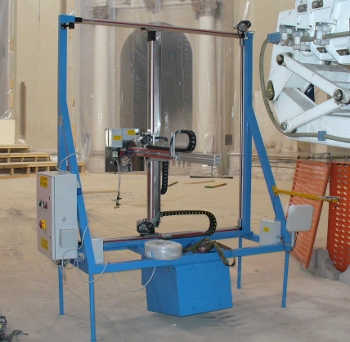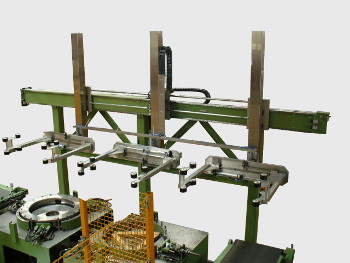homepage
/ robot
/ Custom made robots
CUSTOM MADE CARTESIAN AXIS MANIPULATORS ROBOTS
Solaut produces customized robots to meet specific production needs.
The solutions we can offer cover those applications where standard commercial robots are not technically
or economically usable.
Typical examples are complex movements or those with particularly long strokes.
Cartesian axes can have independent positioning or can be interpolated
(linearly, circularly or with particular curves).
Complex interpolation forms are obtained using axes cards.


ROBOT SAN BERNARDINO
The two figures alongside show a building robot designed to consolidate the dome of the San Bernardino
basilica in the historic center of L'Aquila. The dome is was damaged by the 2009 earthquake.
Since the dome is unsafe, the "San Bernardino" construction robot, mounted on a crane and raised
to a height varying from ground to 40 meters, was used for the first consolidation work.
The controls are completely wireless.
The figure opposite shows the building robot installed on the crane arm.
In the background we see that cracks in the structure of the dome that make it unsafe.
This product was born from the need to strengthen the dome of the basilica of San Bernardino in the city
of L'Aquila, damaged by the earthquake of 2009.
We have been asked to create a robot adapted to operate in hazardous areas, areas where the presence of
operators is prohibited.
The robot can be operated remotely (up to 50 meters) and consists of 3 axes driven by servomotors.
From the first robot, used in San Bernardino, has led to a series of machines with features that allow:
high accuracy and speed of operations.
Download the pdf catalog of the San Bernardino building robot

DRUM HANDLING ROBOT
the figure on the side shows a robot built for handling cardboard drums.
The mantle of the stem is hooked onto a conveyor belt and moves it to the first crimping station of the bottom.
The next step, the robot, hooks the mantle from the feeding belt and moves it to the first lashing station.
At the same time, the stem on the first station is moved to the second that grabs the upper edge, rotating it 180 °.
In the third step, the worked shaft is moved from the second station to the evacuation belt.







